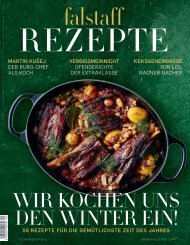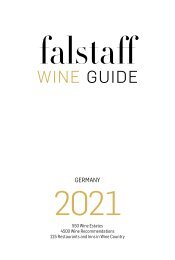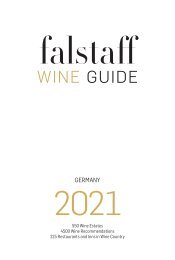Create successful ePaper yourself
Turn your PDF publications into a flip-book with our unique Google optimized e-Paper software.
WHITE WINE VARIETIES<br />
frosts, and even against humidity. On the other<br />
hand, it ripens too early. The resulting wine<br />
has no particular bouquet, tends to be of high<br />
alcohol content, and is mild in acidity. The<br />
Frühroter Veltliner is by no means a trendy<br />
variety and makes up only 0.9 % of the Austrian<br />
vineyards.<br />
FURMINT<br />
This rare variety originates from the Tokaj region<br />
in north-eastern Hungary. It is the main<br />
component of the Hungarian Tokaji wine and<br />
has noth ing to do with the Tokay d’Alsace. In<br />
Austria it is encountered almost exclusively in<br />
Burgenland, particularly in the region around<br />
Rust where it is experiencing a small renaissance.<br />
The Furmint is demand ing of its location<br />
and requires warm, well-drained soils. It<br />
is sensitive to oidium, but has good resistance<br />
to botrytis. The wine is yellow-green when fermented<br />
dry and golden yellow in colour when<br />
sweet. It is intense in bouquet, often reminiscent<br />
of chamomile and quince, usually high in<br />
alcohol, and possesses racy acidity. Because it<br />
can achieve high degrees of extract and alcohol,<br />
it is very well suited to vinification of<br />
sweet predicated wines.<br />
GELBER MUSKATELLER<br />
Synonym: Muscat Blanc á petits grains<br />
Muscat is usually fermented dry in Austria and<br />
comprises a fragrant, light aperitif wine with<br />
refreshing acidity. Muscat has been documented<br />
in the Wachau since 1400. This variety also<br />
has a long tradition in Steiermark and Burgenland,<br />
yet the vineyard area remains very small<br />
since it is extremely susceptible to rot. It is very<br />
demanding of its location, sensitive to frost<br />
and fungal attacks, matures late, but is suitable<br />
for almost any soil, except lime. In addition to<br />
racy, fragrant, light, dry wines, fascinating<br />
sweet wines are also made from this variety in<br />
Austria. The best sweet examples can age for<br />
decades.<br />
GEWÜRZTRAMINER<br />
Synonyms: Roter Traminer,<br />
Gelber Traminer, Traminer<br />
In Austria, Traminer finds its most significant<br />
dissemination in Burgenland, the Thermenregion,<br />
and Steiermark. It is very demanding<br />
of its location and soil, has a low tolerance<br />
for lime, and is sensitive to frost. The wine<br />
typically displays an intense medium yellow<br />
to golden-yellow colour, occasionally with a<br />
slightly reddish shimmer. The fragrance is intense<br />
and reminiscent of rose petals and<br />
marshmallow. Gewürztraminer achieves its<br />
best quality in the upper predicated sweet<br />
wine categories and is quite capable of extended<br />
ageing. Despite being considered a<br />
noble, aristocratic wine, it is not currently<br />
the trend among consumers. Fortunately<br />
there is a committed community of fans, and<br />
its continued existence in Austria is secured.<br />
GRAUER BURGUNDER<br />
Synonyms: Ruländer, Pinot Gris<br />
This noble variety stems from Burgundy and<br />
was brought into Austria and Hungary in the<br />
14th century by Cistercian monks. Its highest<br />
density can be found in north ern Burgenland,<br />
where the Cistercians were once very diligent<br />
viticulturists. Pinot Gris requires deep soils<br />
that are rich in nutrients and a good welldrained<br />
location with regular access to a good<br />
supply of water. Fruit maturity is reached relatively<br />
soon, however the vintage is usually<br />
not until the beginning of October. A wine<br />
with an intensive golden-yellow colour that<br />
sometimes has a mild reddish shimmer and a<br />
delicious varietal bouquet with a touch of<br />
honey. It is typically full bodied and can reach<br />
high levels of alcohol. It currently makes up<br />
less than 0.5 % of Austrian vineyards.<br />
WINE GUIDE <strong>2018</strong><br />
falstaff<br />
<strong>19</strong>


















